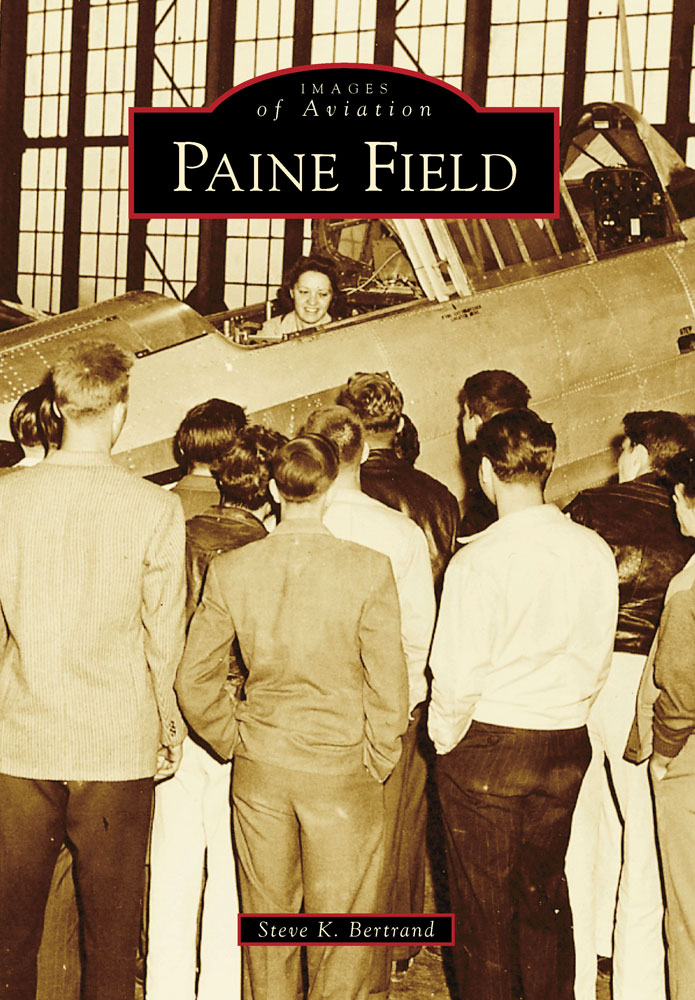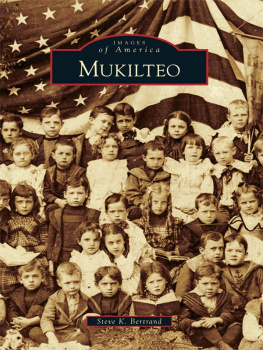
IMAGES
of Aviation
PAINE FIELD

One of my fondest memories from childhood took place during warm, summer evenings, when my father came home from his job at Boeing. He would grab a bite to eat, then invite me to help him in the vegetable garden. By then, it was usually dark. Stars twinkled in the sky. We would root around in the garden by moonlight, pulling weeds, raking the soil, and picking vegetables that had ripened. Because of our close proximity to Paine Field Airport, it was not uncommon to see planes. My father would lean on his shovel and point out the various airplanes, from small Cessnas to large commercial jetliners, that rumbled through the night. It is a cherished memory: a boy and his father contemplating things beyond a humans reach. (Courtesy of the Everett Public Library.)
ON THE COVER: The 1944 photograph shows enlisted reserves during World War II inspecting a weather-scarred US Army Air Corps AT-6 aircraft (now called a T-6) at Paine Field. (Courtesy of the Everett Public Library.)
IMAGES
of Aviation
PAINE FIELD
Steve K. Bertrand

Copyright 2014 by Steve K. Bertrand
ISBN 978-1-4671-3142-1
Ebook ISBN 9781439642795
Published by Arcadia Publishing
Charleston, South Carolina
Library of Congress Control Number: 2013948723
For all general information, please contact Arcadia Publishing:
Telephone 843-853-2070
Fax 843-853-0044
E-mail
For customer service and orders:
Toll-Free 1-888-313-2665
Visit us on the Internet at www.arcadiapublishing.com
For my father and mother, Daniel Hart and Jeanette Lura Bertrand, who instilled a love for flying when we were growing up, through travel and numerous Paine Field Air Shows, and those who embrace the skies by proclaiming, O! for a horse with wings!
CONTENTS
ACKNOWLEDGMENTS
This book would not have come to fruition without the numerous individuals who provided facts, stories, and photographs. Their time, efforts, and expertise are very much appreciated. Through these contributions, it was possible to piece together the 77-year history of Paine Field.
I wish to thank Sgt. Samuel D. Harris of Everetts Air Force Recruiting office; Nona Anderson, Jennifer Eckman, Sandy Johnson, Bill Dolan, Bruce Goetz, and David Waggoner of the Snohomish County Airport; Rod Devol, Paine Field Airport historian; Justin Best of the Everett Herald; Sue Bradley, Boeings director of communications; Sara Bruestle of the Mukilteo Beacon; Michael Cachi of Giclee Prints; Maj. Mark Norton of Civil Air Patrol (Paine Field Squadron); Ann Collier of the Mukilteo Historical Society; Ed Kaplanian, Melody Meyers, and Sandy Ward of the Future of Flight Aviation Center and Boeing Tour; Barbara George and Kim David of the Snohomish County Museum of History; Diane M. Janes and Steven B. Gobin of the Tulalip Tribes; Susan Goff of the Washington State Department of Archaeology and Historic Preservation; Elaine Garcia of the Everett School District; David Dilgard, Melinda Van Wingen, and Lisa Labovitch of the Everett Public Library; Synthia Santos of the Lewis Army Museum; M.Sgt. Ray Jordan of the McChord Air Museum; Melissa Parr of the Hibulb Cultural Center; Richard A. White of the Boeing Company; Mike Lombardi of the Boeing Historical Services; Paul Allen, Cory Graff, and Mari Haug of the Flying Heritage Collection; John T. Sessions and Vanessa Dunn of the Historic Flight Foundation; Ted Huetter, Katherine Williams, Amy Heibrick, and Janice Baker of the Museum of Flight; Carolyn Marr of the Museum of History and Industry; Eric Minnig of Kens Camera; Fred Poyner of the Washington State Historical Society; Robert B. Hood of the Seattle Museum of Flight; Jim Larsen of Aero Acoustics, Inc.; Shana Smith of the Poulsbo Historical Society; Ken and Ethel Cage of the Marysville Historical Society; Terry Wilcoxson of Castle and Cooke Aviation; Nicolette Bromberg of the University of Washington (Special Collections); Commander Matthew J. Kennedy, USN; and Rebecca Coffey and David Mandel of Arcadia Publishing.
In addition, I would like to thank Neil Anderson, Don Bakken, my wife, Donna Marie Bertrand, Patrick Bertrand, Phil Bertrand, Jeff Bohnet, Dick Brooks, Bruce B. Brown, Bill Canavan, Dave Clark, Bob Crump, Audrey Dannar, Beverly (Dudder) Ellis, Gary Evans, Eric Frommer, Max Grinell, George Haage, Brian Hawkins, William Hull, Glenn C. Humann, David Jackson, Peter Jackson, Peter Jensen, Steve Kerber, Pete Kinch, Paul Lasher, John Moberg, Rodney Neff, Jack and Larry ODonnell, George Petrie, Bob Potenza, Joe Ramsdell, Bob Reith, Ron Reardon, Margaret Riddle, Lyle Ryan, Rick Shea, Chuck Smith, Matt Stevens, Norm Story, Christopher Summit, Dr. Matt Thomas, Art Unruh, Joy Webber, Brad Widrig, John Wolcott, and Ron Ziegler.
INTRODUCTION
Paine Field was funded and built by the Works Progress Administration (WPA) in 1936. By 1939, aircraft were flying from the airport. Originally intended as a commercial airport for Snohomish County, plans changed during World War II (19411945), when the site became a military airport. The military would again occupy Paine Field during the Korean conflict. At this time, Paine Field saw both commercial and military involvement. It was not until Snohomish County took full control of the airport in the mid-1960s that new commercial development emerged. The arrival of Boeing in 1966 had a huge economic impact on the local community and aviation commerce.
Throughout its history, Paine Field has been an important hub for general aviation and such businesses as B.F. Goodrich Aerospace, Crown Aviation, and Precision Engines. Today, Paine Field is managed by Snohomish County. Located between Mukilteo and Everett, Paine Field (previously Everett Army Airport) was renamed in 1941 to honor a local Air Corps pilot, 2nd Lt. Topliff Olin Paine (18931922), a veteran of World War I.
The building of Paine Field, originally called Snohomish County Airport, proved one of the largest local relief projects of the Great Depression. Planned by the US Department of Commerce and the WPA, the goal of the project was to provide jobs in the Pacific Northwest and to build a first-class airport. It was pioneer Northwest aviator Elliott Merrill (19011992) who first recommended the site. Merrill Ring Logging and the Pope & Talbot Company owned the 640 acres. Located seventeen miles north of Seattle and eight miles southeast of Everett, the unpopulated location had a reputation of being fog-free. At an elevation of 606 feet, Paine Field lies on a direct route from Portland, Seattle, Vancouver, BC, and Alaska. With Snohomish County matching federal dollars, the work phase began with 300 workers clearing the land. A well provided water for locomotives. Temporary buildings were constructed on skids and moved as the work progressed. At its completion, the Snohomish County Airport had four runways.
World War II would change both the name of the airport and its purpose. In the spring of 1941, the first Army Air Corps arrived. The purpose was to protect Seattles Boeing plant, Bremerton Shipyards, and King County Municipal Airport, home of B-17s and B-29s. At the time, the site was referred to as the Everett Army Airport. It was soon renamed Paine Field. The Air Corps involvement at Paine Field lasted the duration of World War II. It constructed the first control tower at Paine Field, near the Army hangar. Some military personnel remained until 1948. While at Paine Field, the Air Corps made many improvements, including buildings, lighting, and runways. It also constructed aviation fuel storage units used by World War II aircraft, including the B-26.
Next page














